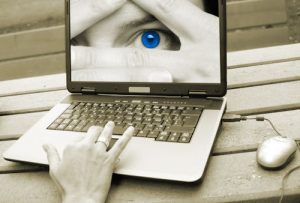Digital eye strain (DES), also known as computer vision syndrome (CVS) affects over 50 percent of people, including both children and adults.
In recent years, the amount of time people spend on all types of digital devices has increased substantially. As a result of advances in technology, increased reliance on computers, smart phones, tablets, and even gaming devices has become the new reality.
According to recent data, approximately 80 percent of Americans use a digital device for more than two hours per day— and 67 percent use two or more devices simultaneously.
Unfortunately, increased device usage may also lead to increased vision problems.
Debunking common myths about digital eye strain
Myth: Computers, tablets, and cell phones do not cause vision problems.
Fact: Actually, prolonged usage of digital devices is a main cause of Computer Vision Syndrome (CVS), otherwise known as Digital Eye Strain. Digital eye strain can cause significant discomfort— sore or tired eyes, blurry vision, dry eyes, headaches, and even neck or shoulder pain.
Myth: Digital eye strain does not affect people who wear corrective eyewear.
Fact: Unfortunately, corrective eyewear cannot always prevent the effects of prolonged screen time. However, computer glasses with anti-reflective coatings can be worn to reduce the symptoms of the condition.
Myth: Digital eye strain does not affect work productivity.
Fact: According to research, digital eye strain does in fact affect work productivity and computer work accuracy, even if symptoms are mild. Moreover, as the day progresses, and screen time accumulates, ocular muscle fatigue will significantly affect accuracy, productivity, and comfort.
Myth: There is no treatment for digital eye strain.
Fact: Digital eye strain can be effectively treated with a program of vision therapy.
According to research, vision therapy can significantly improve symptoms associated with digital eye strain. During vision therapy, you will learn how to train your eyes and brain to work together, to improve your visual skills.
Vision therapy exercises to improve binocular vision may target:
- Eye movement skills
- Eye focusing skills
- Eye teaming skills
Myth: Vision therapy is only effective for children.
Fact: Vision therapy is often just as effective for adults as it is for children, because adults are highly motivated to improve their visual skills.
SEE RELATED: Guide to Vision Therapy for Adults
If you think you may have computer vision syndrome, visit an eye doctor near you who can conduct eye exams to detect any underlying visual problems.
Myth: There aren’t any behavioral changes that will alleviate symptoms of digital eye strain.
Fact: While vision therapy will help to retrain your visual skills and strengthen your binocular vision, there are certain behavioral changes you can make to help reduce your discomfort from digital eye strain.
- Appropriate lighting: Appropriate lighting is important while using a computer— close window curtains and use “soft white” indoor lighting. Also, position your computer with all windows to the side of your screen, instead of behind or in front of it.
- Reduce glare: Purchase an anti-glare screen that can be installed on your computer. Additionally, if you already wear corrective eyeglasses, make sure that your lenses are made with anti-reflective (AR) coatings.
- Replace older computer screens: Newer flat-panel LED screens have an anti-reflective surface to make screen time more comfortable for your eyes.
- Adjust your display settings: The display settings of your computer or digital device can be adjusted to help minimize eye strain and fatigue.
- Brightness. Adjust the brightness of your screen so it’s similar to the brightness of your room.
- Text color and size. Adjust text color and size— black text on a white background is easiest on the eyes.
- Reduce blue light. Adjust the color temperature of your screen to “warmer” colors such as red and orange to reduce blue light emission, which can also cause eye strain. If you are concerned about blue light emissions, computer glasses can be made with specifically tinted lenses, to reduce blue light exposure.
- Keep blinking: To avoid dry eyes, try to remember to blink 10 times (with full eyelid closure), every 20 minutes. Your eye doctor may also recommend eye drops which could provide some relief from dry eyes.
- 20-20-20 rule: The 20-20-20 rule involves looking at something that is 20 feet away, for 20 seconds, every 20 minutes. Looking at distant images relaxes the ocular muscles responsible for focusing, thereby reducing fatigue. Also, take frequent breaks away from your computer to stretch and decrease muscle tension.
- Make your workstation comfortable: Make sure that your desk and chair are at a comfortable height so your feet can rest on the floor, and that your computer screen is positioned just below your eye level and 20-24 inches away from your eyes.
- Computer glasses: Computer glasses may be a good option if you spend many hours on a computer, even if you don’t usually wear glasses for distance or reading. Computer glasses are also helpful if you wear contact lenses and experience dry eyes after prolonged screen time.
When to see an eye doctor
If you are experiencing symptoms of digital eye strain, schedule an eye exam.
Your eye doctor will ask you a series of questions about the amount of time you spend on a digital device each day, and to explain any symptoms you may be experiencing.
LEARN MORE: Guide to Vision Therapy for Adults
Digital technology now takes up a large portion of our day. Let’s make ourselves as comfortable as possible by taking care of our eyes and vision.


